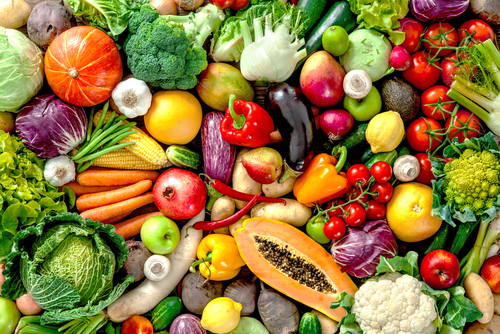Plant Based Kitchen Essentials
Deciding to eat a plant-based diet could very well be the best thing you’ve ever done for your health! And figuring out what you’re going to eat after eliminating meat, dairy and eggs from your diet can be a very scary thing. But never fear, for I am here… To give you a list of plant-based kitchen essentials that will have you cooking gourmet meals in no time!
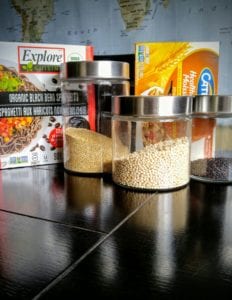
Let’s start with the basics. Most plant-based meals are centred around a whole grain, beans/legumes/source of protein, vegetables and fruit. Whole grains that I like to have on hand are quinoa (also a great source of protein,) barley, sorghum forbidden (black) rice, and 100% whole grain pastas and breads. But don’t be afraid to experiment and find options that you and your family love!
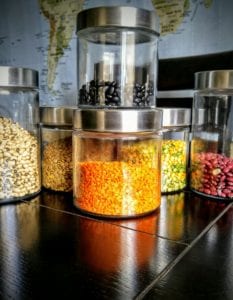
Beans and legumes include black beans, navy beans, kidney beans, green/red/black lentils, mung beans, chickpeas (garbanzo beans) etc…..the list is a mile long, again experimenting is key! I always have a few different types of beans (black, kidney, navy etc.,) chickpeas (for HUMMUS) and a few different kinds of lentils kicking around in my pantry.
Other plant based sources of protein that are also great to have around are tofu, tempeh (fermented soybeans), green peas, edamame and seitan (also known as “wheat meat” made from vital wheat gluten.) Mushrooms, jackfruit and hearts of palm are delicious meat alternatives in dishes such as “sloppy joes,” “pulled pork,” and “crab cakes.” And don’t worry if you’ve never heard of some of these things, you will become a pro at turning them into crowd pleasing meals in no time!
Dairy substitutes include a wide variety of plant based milks, cheeses (such as almond, soy and cashew) and yogurts etc. I prefer to use full fat coconut milk as a substitute for heavy cream in curries, soups and stews. Again, it is just trial and error to find the alternatives that you like best. Oh…and don’t worry, you won’t have to give up ice-cream or cheesecake as there are many delicious dairy-free options!
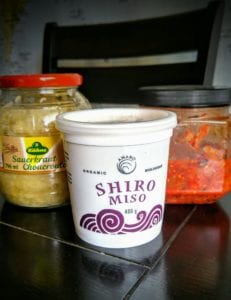
Fermented foods such as kimchi, and sauerkraut add so much flavour and gut-healthy probiotics to your diet. As well as miso (fermented soybeans) which adds a delicious, savoury “umami” flavour to soups and sauces.
Having a variety of nuts and seeds on hand is also important as they add healthy fats, essential nutrients, protein and fibre to our diets. Some of my favourite seeds include hemp, flax (ground) and chia seeds which can also be used as egg substitutes in recipes. Along with cashews (which can be used to make creamy sauces such as nacho “cheese” and ranch dressing,) almonds, walnuts (also used as a “ground meat” substitute in tacos, burritos and chilis etc.,) and pine nuts (for making delicious plant-based pestos!!)

Fruits and vegetables I will leave up to you, but it is important to keep a variety of both fresh and frozen on hand at all times. As far as I’m concerned, most vegetables are unlimited so EAT AS MANY AS YOU WANT, and eating 2-3 servings of fruit/ day is ideal. Find ones that you like, but be sure to eat a variety as to get all the nutritional benefits that nature has to offer!
And the #1 most important essential ingredients in the kitchen… HERBS AND SPICES! In my opinion anyways, these are what add flavour and dimension to your dishes. Learning to use both fresh and dried herbs along with your favourite spices can take a dish from mediocre to WOW in just a few sprinkles. I have a fully stocked spice rack but some of my favourites to have on hand are smoked paprika, turmeric, cumin, cayenne, basil, parsley, dill, jalapeño powder, cardamom, sumac, sweet paprika, Himalayan pink salt, black pepper, black salt, curry, garlic powder and onion powder! And you can never go wrong adding fresh herbs such as basil, parsley, dill and cilantro to a dish before serving. The best part about herbs and spices is that they pack a mighty nutritional punch into a small package so don’t be afraid to use them freely!!
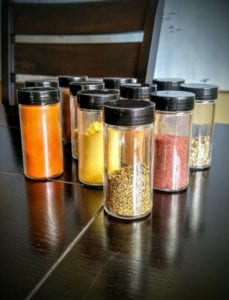
Some specialty items that you may have heard about include things such as nutritional yeast, which is used to add a “cheesy” flavour to dishes and, as a bonus, is CHOCK full of vitamins and minerals!! As well as vital wheat gluten, which is low in fat and high in protein, and used to make popular “mock meat” products called seitan. Wheat germ is also added to dishes since, unless you use a boatload, it is mostly undetectable and it also adds a ton of essential nutrients to your diet.
In summary, having a variety of whole grains, beans/legumes and protein alternatives, fruits and veggies, nuts and seeds and herbs and spices on hand is the key to having a fully stocked plant-based kitchen! But you don’t have to change everything all at once! Experiment and try new things until you find what you like. Before you know it, you’ll be cooking better than you ever have before!!
